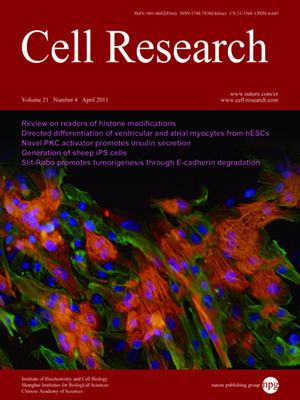
Volume 21, No 4, Apr 2011
ISSN: 1001-0602
EISSN: 1748-7838 2018
impact factor 17.848*
(Clarivate Analytics, 2019)
Volume 21 Issue 4, April 2011: 600-608
ORIGINAL ARTICLES
Reprogramming of ovine adult fibroblasts to pluripotency via drug-inducible expression of defined factors
Lei Bao1,*, Lixiazi He1,*, Jijun Chen1, Zhao Wu1, Jing Liao1, Lingjun Rao1, Jiangtao Ren1, Hui Li3, Hui Zhu1, Lei Qian1, Yijun Gu1, Huimin Dai1, Xun Xu5, Jinqiu Zhou2, Wen Wang5, Chun Cui1,4 and Lei Xiao1,4
1Laboratory of Molecular Cell Biology, Institute of Biochemistry and Cell Biology, Shanghai Institutes for Biological Sciences, Chinese Academy of Sciences, Shanghai 200031, China
2The State Key Laboratory of Molecular Biology, Institute of Biochemistry and Cell Biology, Shanghai Institutes for Biological Sciences, Chinese Academy of Sciences, Shanghai 200031, China
3Xiangtan Center Hospital, Hunan 411100, China
4College of Animal Sciences, Zhejiang University, Hangzhou 310058, China
5CAS-Max Planck Junior Research Group, State Key Laboratory of Genetic Resources and Evolution, Kunming Institute of Zoology, Chinese Academy of Sciences, Kunming, Yunnan 650223, China
Correspondence: Lei Xiao,(leixiao@sibs.ac.cn, leixiao@zju.edu.cn)
Reprogramming of somatic cells in the enucleated egg made Dolly, the sheep, the first successfully cloned mammal in 1996. However, the mechanism of sheep somatic cell reprogramming has not yet been addressed. Moreover, sheep embryonic stem (ES) cells are still not available, which limits the generation of precise gene-modified sheep. In this study, we report that sheep somatic cells can be directly reprogrammed to induced pluripotent stem (iPS) cells using defined factors (Oct4, Sox2, c-Myc, Klf4, Nanog, Lin28, SV40 large T and hTERT). Our observations indicated that somatic cells from sheep are more difficult to reprogram than somatic cells from other species, in which iPS cells have been reported. We demonstrated that sheep iPS cells express ES cell markers, including alkaline phosphatase, Oct4, Nanog, Sox2, Rex1, stage-specific embryonic antigen-1, TRA-1-60, TRA-1-81 and E-cadherin. Sheep iPS cells exhibited normal karyotypes and were able to differentiate into all three germ layers both in vitro and in teratomas. Our study may help to reveal the mechanism of somatic cell reprogramming in sheep and provide a platform to explore the culture conditions for sheep ES cells. Moreover, sheep iPS cells may be directly used to generate precise gene-modified sheep.
Cell Research (2011) 21:600-608. doi:10.1038/cr.2011.6; published online 11 January 2011
FULL TEXT | PDF
Browse 2310


